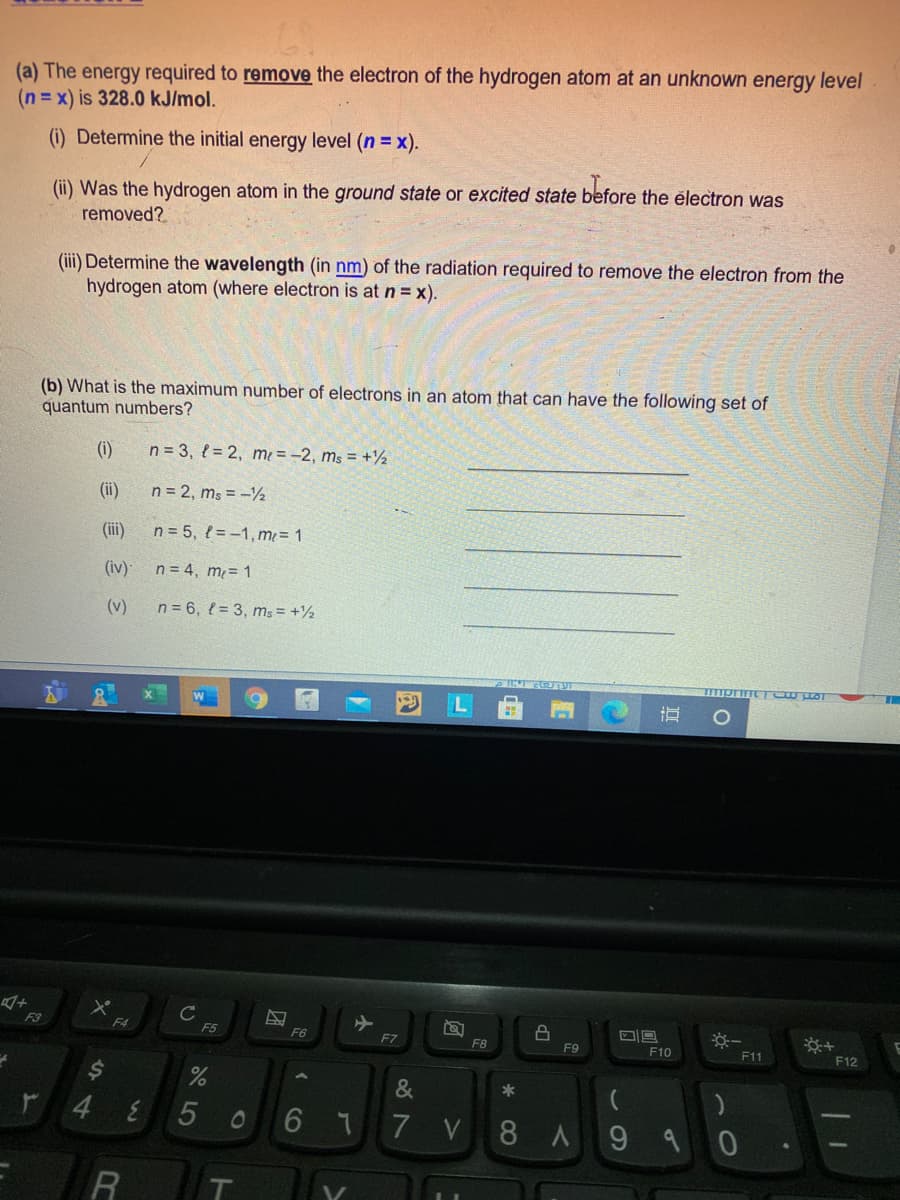(b) What is the maximum number of electrons in an atom that can have the following set of quantum numbers? (i) n = 3, {= 2, mı = -2, ms = +½ (ii) n = 2, ms =-k (ii) n = 5, { = -1, mį = 1 (iv) n= 4, m= 1 (v) n = 6, { = 3, ms = +½
(b) What is the maximum number of electrons in an atom that can have the following set of quantum numbers? (i) n = 3, {= 2, mı = -2, ms = +½ (ii) n = 2, ms =-k (ii) n = 5, { = -1, mį = 1 (iv) n= 4, m= 1 (v) n = 6, { = 3, ms = +½
Chemistry
10th Edition
ISBN:9781305957404
Author:Steven S. Zumdahl, Susan A. Zumdahl, Donald J. DeCoste
Publisher:Steven S. Zumdahl, Susan A. Zumdahl, Donald J. DeCoste
Chapter7: Atomic Structure And Periodicity
Section: Chapter Questions
Problem 13ALQ
Related questions
Question

Transcribed Image Text:(a) The energy required to remove the electron of the hydrogen atom at an unknown energy level
(n = x) is 328.0 kJ/mol.
(i) Determine the initial energy level (n = x).
(ii) Was the hydrogen atom in the ground state or excited state before the électron was
removed?
(iii) Determine the wavelength (in nm) of the radiation required to remove the electron from the
hydrogen atom (where electron is at n = x).
(b) What is the maximum number of electrons in an atom that can have the following set of
quantum numbers?
(i)
n = 3, l = 2, me = -2, ms = +½
(ii)
n = 2, ms = -½
(ii)
n = 5, { = -1, m = 1
(iv)
n = 4, m= 1
(v)
n = 6, { = 3, ms = +½
C
F5
F3
F4
F6
F7
F8
F9
F10
F11
F12
2$
&
*
r 4
6 77 V
01
8 A
9.
木
Expert Solution
This question has been solved!
Explore an expertly crafted, step-by-step solution for a thorough understanding of key concepts.
Step by step
Solved in 2 steps with 1 images

Knowledge Booster
Learn more about
Need a deep-dive on the concept behind this application? Look no further. Learn more about this topic, chemistry and related others by exploring similar questions and additional content below.Recommended textbooks for you

Chemistry
Chemistry
ISBN:
9781305957404
Author:
Steven S. Zumdahl, Susan A. Zumdahl, Donald J. DeCoste
Publisher:
Cengage Learning

General Chemistry - Standalone book (MindTap Cour…
Chemistry
ISBN:
9781305580343
Author:
Steven D. Gammon, Ebbing, Darrell Ebbing, Steven D., Darrell; Gammon, Darrell Ebbing; Steven D. Gammon, Darrell D.; Gammon, Ebbing; Steven D. Gammon; Darrell
Publisher:
Cengage Learning

Chemistry: The Molecular Science
Chemistry
ISBN:
9781285199047
Author:
John W. Moore, Conrad L. Stanitski
Publisher:
Cengage Learning

Chemistry
Chemistry
ISBN:
9781305957404
Author:
Steven S. Zumdahl, Susan A. Zumdahl, Donald J. DeCoste
Publisher:
Cengage Learning

General Chemistry - Standalone book (MindTap Cour…
Chemistry
ISBN:
9781305580343
Author:
Steven D. Gammon, Ebbing, Darrell Ebbing, Steven D., Darrell; Gammon, Darrell Ebbing; Steven D. Gammon, Darrell D.; Gammon, Ebbing; Steven D. Gammon; Darrell
Publisher:
Cengage Learning

Chemistry: The Molecular Science
Chemistry
ISBN:
9781285199047
Author:
John W. Moore, Conrad L. Stanitski
Publisher:
Cengage Learning

Chemistry for Engineering Students
Chemistry
ISBN:
9781337398909
Author:
Lawrence S. Brown, Tom Holme
Publisher:
Cengage Learning

Chemistry: Principles and Practice
Chemistry
ISBN:
9780534420123
Author:
Daniel L. Reger, Scott R. Goode, David W. Ball, Edward Mercer
Publisher:
Cengage Learning

Chemistry & Chemical Reactivity
Chemistry
ISBN:
9781337399074
Author:
John C. Kotz, Paul M. Treichel, John Townsend, David Treichel
Publisher:
Cengage Learning